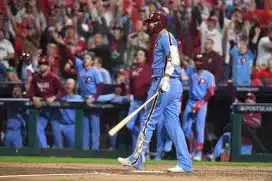Flyers
As Phase 3 Starts, Next 2 Weeks are Critical to Finishing NHL Season
By Kevin Durso, Sports Talk Philly editor
Sunday marked exactly four months since the NHL joined the rest of the major sports leagues in pausing the season due to the COVID-19 pandemic and it has been a marathon to get to this point. There have been weeks of waiting, weeks of creating a plan, weeks of refining the plan to get it approved by both the league and players and a lot of talk not only about the return to play, but also the overall status and future of the league and sport with the agreement on a Memorandum of Understanding to the Collective Bargaining Agreement, extending labor peace for four additional seasons through the 2025-26 season.
It has brought the NHL here, to the start of Phase 3 of their return-to-play plan. Teams are back on the ice for formal training camps and in just under two weeks, they will travel to the two hub cities of Toronto and Edmonton to complete the 2019-20 season with a 24-team tournament.
It is a plan that has gone through very specific deliberation and planning, but at this time of such great uncertainty in the world, that is all that this is. It is simply a plan, and even the best-laid and well thought out plans don’t always work out.
The NHL carefully observed the landscape of the finalists for hub cities. For weeks, Vegas was a favorite. A spike in positive COVID-19 cases changed all of that and forced the NHL to choose to hold this tournament exclusively in Canada, where the number of cases is much lower. That said, for the next two weeks, anything is possible.
There are 24 teams that are entering Phase 3 on Monday, and with the exception of the Toronto Maple Leafs and Edmonton Oilers, who both will remain in their home cities throughout Phase 3 and not need to travel ahead of Phase 4, there could certainly be complications.
With all teams training in their home practice facilities, you are left with the risk that a team in a current hot spot for COVID-19 or a player who chooses to take part in an extracurricular activity away from home and the practice facility could still contract the virus. Think of players on teams like the Florida Panthers, Dallas Stars, Arizona Coyotes or Tampa Bay Lightning — a team that already had to briefly close their practice facility during Phase 2 because of a COVID-19 outbreak.
It’s not to say that the players on any of those teams are going to deliberately be irresponsible and put themselves at risk of potentially becoming infected by the virus. More, this is about the risk that comes with having 24 teams with a minimum of 31 players in camp all trying to accomplish the same goal. By those numbers, at least 800 players are going to be in the same position, trying to get through the next two weeks of training camp and get into the Phase 4 bubble without an outbreak happening.
Every week, the NHL has released numbers on positive cases among players. As of the last update of Phase 2, there were 23 positive tests out of 396 players, roughly half of the league’s participants in Phase 3. With the number set to increase at the start of Phase 3 testing, it’s possible that numbers could go up and the percentage of positive tests among players — which has consistently stayed around six percent — could rise.
Granted, in each update, there has been a positive side to the results. The first update stated that an excess of 200 players were tested during Phase 2 protocols and 11 were positive. In the next week, only four new positive cases were reported with an additional 50-plus players testing. Eight new cases were reported in last week’s update, but the total number of players tested increased by approximately 146 players. It would not be a surprise to find that there is another number of positive cases among nearly 800 players being tested.
Of course, there is also an undisclosed number of positive cases that would surely create a lot of pause in resuming play. The Tampa Bay Lightning had three players and two staffers test positive and shut down the facility for several days. A report on Sunday night, the eve of Phase 3 camp, indicated that the Montreal Canadiens also had at least three positive tests among players.
It makes it very critical that the players do everything they can to protect themselves and their families during this time. Their participation in Phase 4 depends on a successful Phase 3, which is certainly a challenge when players are scattered across 24 different cities.
A common belief is that once the NHL reaches Phase 4 and has players secured inside the bubble that the league would be able to successfully complete the season because of the isolation the players would have, all in the same space. That said, you have to get there first and hope that there is no outbreak before that.
After getting a lot of answers on the CBA and return-to-play protocols, it’s possible the only question remaining before games take place and the league moves to Phase 4 is if they can get there. It will take the next two weeks to firmly answer that question.












































